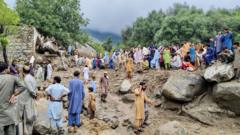At least 164 individuals have tragically lost their lives over the last day due to severe monsoon floods and subsequent landslides across Pakistan and Pakistan-administered Kashmir. The majority of fatalities, totaling 150, were reported in the northern Khyber Pakhtunkhwa province, an area prone to such disasters. Rescue efforts were further complicated when a helicopter, tasked with evacuation missions, crashed during operations due to adverse weather conditions, leading to the loss of five crew members.
Nine lives were lost in Pakistan-administered Kashmir, while an additional five deaths were recorded in the Gilgit-Baltistan region. Government forecasts warn of continued heavy rainfall until August 21, leading to declarations of disaster zones in several affected regions.
In Khyber Pakhtunkhwa, crowds gathered around excavators working tirelessly to clear mud from stricken areas, as community members mourned the loss of their loved ones. In Indian-administered Kashmir, rescuers continued to search for missing individuals amid reports of at least 60 fatalities after floods ravaged a Himalayan village.
The monsoon season, typically spanning from June to September, is responsible for approximately 75% of South Asia's annual rainfall, yet this year has already seen more than 300 deaths due to landslides and flooding, with Punjab province experiencing a staggering 73% increase in rainfall compared to the previous year.
Experts have pointed to climate change as a significant factor behind the rising frequency and intensity of weather-related disasters, underlining the urgent need for better climate policies and infrastructure investment to safeguard vulnerable communities.





















